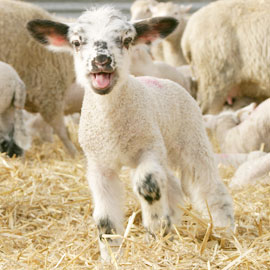Minimising lamb losses: case study

Ensuring triplets receive enough colostrum and paying close attention to at-risk lambs has helped one Hertfordshire farm minimise lamb losses, Aly Balsom reports.
Colostrum management is the crux to the system at Thrift Farm, Royston, according to shepherdess, Lorraine Logan.
Each set of triplets, as they are born and before they can stand up and suckle, are given 150-170ml of cow colostrum, which is stockpiled in deep freezers from a neighbouring dairy.
“When time permits and lambs are keen to suckle they will be encouraged to suck a bottle, if not they are stomach tubed the correct amount,” explains Ms Logan.
The theory behind this is that with a limited supply of colostrum, stronger triplet lambs will suck all of the ewe colostrum before siblings get a chance and hence will be more susceptible to bacterial infections.
“With a lesser immunity, after a few days these lambs begin to show themselves more obviously with a prominent backbone. If any lambs from a set of triplets show signs of hunger within 24 hours of being born they will be topped up with another dose of colostrum.”
With 2,500 breeding females – including 650 Dorset Mules, 450 Texel Mules and 1,400 North Country Mules – this is no small task. However, Ms Logan views it as essential.
“The use of cow colostrum allows each of the lambs to have a fairer chance at getting some of the ewe’s colostrum, which will also help to protect them in the short term against clostridial diseases via the vaccine booster the ewe had prior to lambing,” she says.
This same technique is also used for twins or single, but only if the ewe is identified as she is penned up as being short of milk. Such practices mean lamb mortality figures for 2010-11 sat at about 15%.
Lamb treatment
On lambing, each lamb has its navel dipped – not sprayed – with at least 10% strong iodine solution, to prevent infections such as navel-ill, causing ill thrifty lambs. Every lamb, regardless of being a natural single, twin or triplet, is also treated with scour halt to prevent watery mouth.
We see very low incidence of watery mouth, says Ms Logan. “In 2011, I can only recall two cases in the triplet shed. However, this can also be attributed to the use of cow colostrum.”
As ewes and lambs are turned out from individual pens, each pen is disinfected with absorbent disinfectant and re-bedded with clean straw.
About 100 sets of triplets will remain on the ewe and these are selected on how well the lambs are growing/performing, how much milk the ewe has, if the ewe is full mouthed, age of ewe and condition score of ewe.
Fostering
About 100 natural singles will be twinned on with a triplet lamb and are selected on the size of their own lamb and how much milk the ewe has.
Aged triplet lambs, which are not turned out as a three or twinned on, will be lifted and started in the pet pen system. These are most commonly selected by either being the hungriest or smallest of the three lambs.
Once in the pet pen system, lambs are started on the bottle for several feeds until they are introduced to the starter pen on automated milk machines.
“There can be as many as 100 lambs that we hand feed to begin with. Everyone mucks in so they are all fed at once. By doing it this way, we can keep track of what individuals are drinking.”
As they learn to suck the machine, they are moved into an intermediate pen and then to an advanced pen, where they will be injected with 0.5ml selenium/vitamin E to aid the prevention of white muscle disease. They will also be administered with another dose of scour halt. All lambs are also vaccinated against clostridial diseases and shearlings are vaccinated against abortion.
